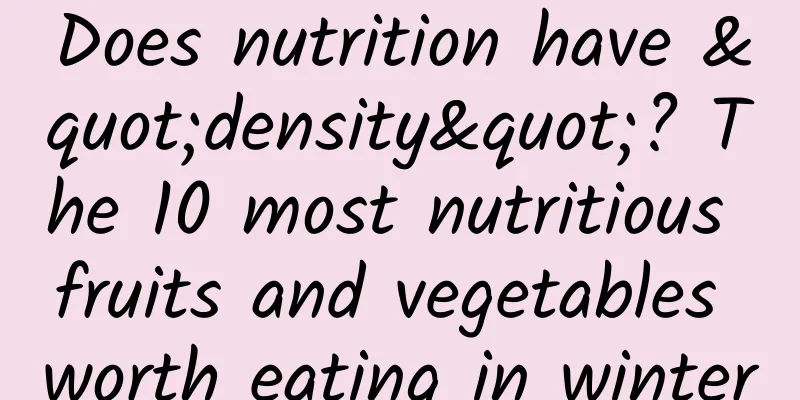Does nutrition have "density"? The 10 most nutritious fruits and vegetables worth eating in winter

|
Some foods can provide a lot of nutrition with just a small bite, while some foods, even if eaten in a large bowl, will only make you feel full and bloated, but you will get very little nutrition. This is due to the difference in the nutritional density of the food. "Nutrient density" refers to the concentration of important nutrients in a food on a per-calorie basis. High-nutrient-density foods are foods that are high in vitamins, minerals, dietary fiber, and phytochemicals or essential fatty acids, but should also contain relatively little fat, sugar, and energy. So, which vegetables and fruits have high nutritional density in winter? In today’s article, the author has compiled 10 kinds of fruits and vegetables that are high in nutritional density and suitable for consumption in winter. Don’t miss them. Image source: pixabay Top 5 vegetables Recommendation basis: outstanding nutritional content, common and cheap. (Many vegetables are very nutritious, but some are not common or expensive, so they are not recommended this time, but not being selected does not mean they are bad.) No.1 Spinach The first thing I want to recommend is spinach. Spinach has the highest content of vitamin K among all foods. It also has high content of antioxidant nutrients such as beta-carotene and lutein, as well as folic acid. Vitamin K can promote calcium deposition in bones and strengthen bone hardness; beta-carotene and lutein can not only help the body remove free radicals, but also have a certain effect of protecting the cardiovascular system and are also very helpful for eye health. In addition, folic acid is also very friendly to the cardiovascular system. It should be noted that although spinach is high in nutrients, it also has a high oxalic acid content. Its astringent taste will affect the absorption of minerals such as calcium and iron. Therefore, it should be blanched in advance when cooking, which can remove most of the oxalic acid. In addition, fresh spinach should be selected for cooking, as unfresh spinach has a high nitrite content. No.2 Broccoli Broccoli is a cruciferous vegetable rich in isothiocyanates. In addition, it is also high in folic acid, containing 210μg of folic acid per 100g. Image source: pixabay Isothiocyanates can inhibit cancers induced by a variety of carcinogens. Meta-analysis found that increasing the proportion of cruciferous vegetables in the diet is associated with a reduced risk of gastric cancer, breast cancer, and lung cancer. The U.S. Cancer Prevention Guidelines list eating more cruciferous vegetables as one of the recommendations. In addition, folic acid is helpful in preventing cardiovascular disease and neural tube defects in the fetus. No.3 Shiitake Mushrooms Shiitake mushrooms are a member of the mushroom family and are rich in polysaccharides. In addition, shiitake mushrooms are one of the few plant foods with a relatively high vitamin D content, with each 100g of fresh shiitake mushrooms containing 1.6μg of vitamin D. Mushroom polysaccharides have the effects of immune regulation, anti-tumor, and regulating blood sugar and blood lipids. They are very friendly to people with low immunity, cancer patients, and friends with cardiovascular diseases. Vitamin D can promote calcium absorption. In addition, shiitake mushrooms are low in calories and are very suitable for friends who need to control their calorie intake. No.4 Carrot As the saying goes, "carrots are little ginseng." Although this statement is an exaggeration, carrots are indeed rich in nutrients. Carrots’ beta-carotene ranks among the highest among common vegetables. Beta-carotene not only has antioxidant and anti-inflammatory effects, but can also be converted into vitamin A in the body, which is essential for maintaining the integrity of epithelial cells and ensuring the health of the respiratory tract. In addition, beta-carotene itself can enhance the immune function of cells and reduce the occurrence of infectious diseases. Carrots are also good at cooking. They have bright colors, increase appetite, and go well with many vegetables. No.5 Rapeseed Rapeseed is a well-deserved popular vegetable. It is available all year round and suitable for all kinds of meals. It is low in calories and high in calcium. It contains 148 mg of calcium per 100 g, which is 1.4 times the same weight of milk. If it is black rapeseed, the calcium content is even higher, with 191 mg of calcium per 100 g. If you drink less milk, you can consider making rapeseed a regular ingredient in your diet. Top 5 fruits Unlike nutrient-rich vegetables, the nutrition of fruits is relatively simple, mainly vitamin C, potassium, dietary fiber and some antioxidant phytochemicals. Recommendation basis: Good nutrition, seasonal, and relatively low in sugar. No.1 Kiwi Kiwi fruit is a common fruit rich in vitamin C , with 62 mg of VC per 100 g. Eating one and a half kiwis can meet the 100 mg daily requirement of an adult. In addition to vitamin C, the lutein and zeaxanthin content in kiwi fruit is relatively high among fruits. Although it is not as high as vegetables, it is a supplement for those who eat less dark vegetables. Image source: pixabay In addition to helping iron absorption, vitamin C can also promote the synthesis of collagen, making the skin rosy and elastic. VC can also resist oxidation and help form antibodies to improve the body's immunity. No.2 Strawberry Strawberries are seasonal fruits in winter and are very low in calories, with only 32 kcal in 100 grams, making them especially suitable for those who want to control calories. In addition, although the vitamin C content of strawberries is not as high as that of kiwifruit, it is higher than that of tangerines and oranges. Eating six or seven large strawberries can meet the daily VC needs. Strawberries have the highest folic acid content among fruits, with 32μg of folic acid per 100g. In addition, strawberries also contain antioxidant ingredients such as anthocyanins and polyphenols , which have antioxidant and anti-inflammatory effects. The small seeds on the surface can also help gastrointestinal peristalsis, helping the body to "detoxify" in a two-pronged way. No.3 Grapefruit Grapefruit looks ordinary, its energy is not the lowest, and its vitamin C content is not very high. However, among seasonal fruits in winter, grapefruit has low sugar content and raises blood sugar slowly, so it is worth recommending. However, although grapefruit is good, you should also pay attention to controlling the amount of consumption. Especially for diabetics, it is best to eat no more than 3 grapefruit slices a day, in divided doses. No.4 Pear Pears are rich in dietary fiber. Every 100g of pears contains about 2.6g of dietary fiber, while Korla pears contain up to 6.2g, which is top-tier content among fruits. Image source: pixabay Dietary fiber contributes to digestive health and bowel movements. In the latest dietary guidelines released by the World Health Organization in July, it is strongly recommended that adults should consume at least 25g of dietary fiber per day through natural foods. In addition, pears also contain fructose and sorbitol, which are helpful for intestinal peristalsis. It is a fruit worth trying for those who often suffer from constipation. However, for those with weak gastrointestinal function, it is recommended to eat less or choose varieties with less dietary fiber, such as snow pear and moon pear. No.5 Apple Although there are many kinds of fruits now, apple is one of the few fruits that we can eat from childhood to adulthood. Although apples do not contain high levels of vitamin C, they are rich in antioxidant polyphenols, chlorogenic acid, flavonoids and other phytochemicals, and their blood sugar-raising rate is not the fastest among fruits. In addition, they are affordable, so they are worth recommending in winter. Apples are rich in pectin. If you don’t like eating cold fruits in the winter, hot, plump baked apples or apples cooked with rock sugar are also very delicious. There are many more nutritious vegetables and fruits, which cannot be listed here one by one. "Nutrient density" is a valuable concept, which can be used as a concept when choosing food, but if you want to eat healthily, you still need to pay attention to food diversification, eat more dark-colored fruits and vegetables, and ensure that there are vegetables at every meal (300-500g per day) and fruits every day (200-350g per day). Only when the food is diverse can the nutrition complement each other. References [1] Yang Yuexin. Chinese Food Composition Table Standard Edition, 6th Edition, Volume 1[M]. Beijing: Peking University Medical Press, 2018. [2] Yang Yuexin and Ge Keyou. Encyclopedia of Chinese Nutrition Science, 2nd edition (Volume 1) [M]. Beijing: People's Medical Publishing House, 2019. [3] Chinese Nutrition Society. Dietary Reference Intakes of Nutrients for Chinese Residents (2023 Edition)[M]. Beijing: People's Medical Publishing House, 2023. [4] Chinese Nutrition Society. Dietary Reference Intakes of Nutrients for Chinese Residents (2013 Edition) [M]. Beijing: Science Press, 2014. [5]Carbohydrate intake for adults and children: WHO guideline. Geneva: World Health Organization; 2023. License: CC BY-NC-SA 3.0 IGO. [6]USDA, Food Data Central, Mushroom, maitake, https://fdc.nal.usda.gov/fdc-app.html#/food-details/2003602/nutrients [7] Japanese food composition table. http://www.mext.go.jp/a_menu/syokuhinseibun/1365297.htm Planning and production Author: Li Chun, a registered nutritionist in China Review | Ruan Guangfeng, Deputy Director of Kexin Food and Health Information Exchange Center Planning丨Zhong Yanping Editor: Zhong Yanping |
<<: Photovoltaic, born towards the sun, will be the leader in renewable energy power in 2050!
Recommend
iPhone X vs Xiaomi Mi MIX 2: Which one do you choose, the bangs or the chin?
Xiaomi Mi MIX 2 and iPhone X have once again prov...
Musk did not brag and published a statement announcing the source of funds for privatization
On August 13th local time, Musk announced some de...
Following the trend of Internet celebrities’ “fire control skills”, firefighters remind: beware of dust explosions!
Review expert: Zhou Hongzhi, senior experimenter ...
Xiaohongshu’s complete promotion and operation plan!
At the beginning, my purpose of operating Xiaohon...
What is a clear process for setting up a Toutiao account?
The Bytedance advertising platform, also known as...
Does the Zhengxin Mini Program take up space? Do WeChat mini-programs take up space on my phone?
Will using mini-apps take up storage space on you...
Will watermelon and crayfish cause poisoning? Will watermelon and peach cause diarrhea? Are there so many rules for eating watermelon?
In the hot summer, people often feel the heat is ...
Guide to writing scripts for live broadcast rooms!
Why is “Lipstick King” Li Jiaqi so awesome? Some ...
Dai Jifeng | The “Temperature” of Traffic
"The problem of 'Chinese-style roads'...
Apple wins new patent: iPhone will be able to "track friends"
According to foreign media reports, Apple obtaine...
iOS 14.5 is available first! 217 new emojis added, green screen issue fixed
Apple's iOS system is very comfortable to use...
Campus recruitment strategy: 43 high-quality interview experiences (iOS development)
sequence I am a senior undergraduate student (maj...
K12 Online Education User Growth Traps
Education is one of the best means of transferrin...
What do you need to know about SEO: Do you know the common sense of website optimization? How to do SEO well?
In the early stages of website construction, rele...
Product promotion, traffic monetization... How Tencent Advertising Alliance sets the pace for the information industry
How to promote traffic monetization to improve RO...









